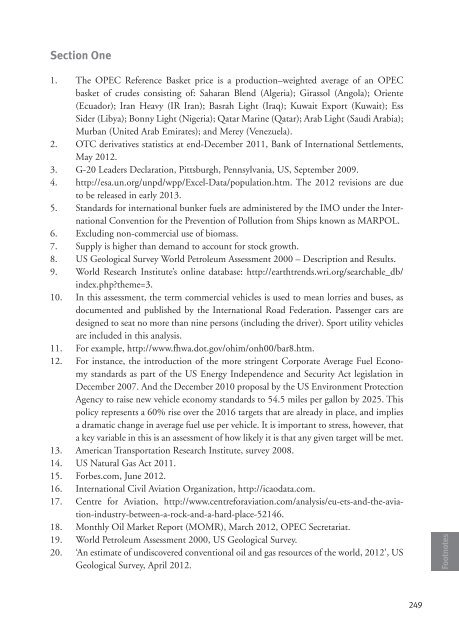World Oil Outlook - Opec
World Oil Outlook - Opec
World Oil Outlook - Opec
- TAGS
- world
- outlook
- opec
- www.opec.org
You also want an ePaper? Increase the reach of your titles
YUMPU automatically turns print PDFs into web optimized ePapers that Google loves.
Section One<br />
1. The OPEC Reference Basket price is a production–weighted average of an OPEC<br />
basket of crudes consisting of: Saharan Blend (Algeria); Girassol (Angola); Oriente<br />
(Ecuador); Iran Heavy (IR Iran); Basrah Light (Iraq); Kuwait Export (Kuwait); Ess<br />
Sider (Libya); Bonny Light (Nigeria); Qatar Marine (Qatar); Arab Light (Saudi Arabia);<br />
Murban (United Arab Emirates); and Merey (Venezuela).<br />
2. OTC derivatives statistics at end-December 2011, Bank of International Settlements,<br />
May 2012.<br />
3. G-20 Leaders Declaration, Pittsburgh, Pennsylvania, US, September 2009.<br />
4. http://esa.un.org/unpd/wpp/Excel-Data/population.htm. The 2012 revisions are due<br />
to be released in early 2013.<br />
5. Standards for international bunker fuels are administered by the IMO under the International<br />
Convention for the Prevention of Pollution from Ships known as MARPOL.<br />
6. Excluding non-commercial use of biomass.<br />
7. Supply is higher than demand to account for stock growth.<br />
8. US Geological Survey <strong>World</strong> Petroleum Assessment 2000 – Description and Results.<br />
9. <strong>World</strong> Research Institute’s online database: http://earthtrends.wri.org/searchable_db/<br />
index.php?theme=3.<br />
10. In this assessment, the term commercial vehicles is used to mean lorries and buses, as<br />
documented and published by the International Road Federation. Passenger cars are<br />
designed to seat no more than nine persons (including the driver). Sport utility vehicles<br />
are included in this analysis.<br />
11. For example, http://www.fhwa.dot.gov/ohim/onh00/bar8.htm.<br />
12. For instance, the introduction of the more stringent Corporate Average Fuel Economy<br />
standards as part of the US Energy Independence and Security Act legislation in<br />
December 2007. And the December 2010 proposal by the US Environment Protection<br />
Agency to raise new vehicle economy standards to 54.5 miles per gallon by 2025. This<br />
policy represents a 60% rise over the 2016 targets that are already in place, and implies<br />
a dramatic change in average fuel use per vehicle. It is important to stress, however, that<br />
a key variable in this is an assessment of how likely it is that any given target will be met.<br />
13. American Transportation Research Institute, survey 2008.<br />
14. US Natural Gas Act 2011.<br />
15. Forbes.com, June 2012.<br />
16. International Civil Aviation Organization, http://icaodata.com.<br />
17. Centre for Aviation, http://www.centreforaviation.com/analysis/eu-ets-and-the-aviation-industry-between-a-rock-and-a-hard-place-52146.<br />
18. Monthly <strong>Oil</strong> Market Report (MOMR), March 2012, OPEC Secretariat.<br />
19. <strong>World</strong> Petroleum Assessment 2000, US Geological Survey.<br />
20. ‘An estimate of undiscovered conventional oil and gas resources of the world, 2012’, US<br />
Geological Survey, April 2012.<br />
249<br />
Footnotes
















